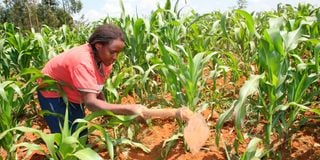Twitter forum lays bare the problem with Kenya's GMO rules

A farmer weeds her maize crop at Yamumbi in Eldoret. Experts say yields from genetically modified crops are higher and cheaper to grow. Some people are opposed to the importation of GM maize saying it is not fit for consumption
Kenya’s regulatory framework is yet to factor in secondary consumers of genetically modified (GM) products, leaving people who don’t like GM food in a conundrum.
During a Twitter Space discussion hosted by the Nation on Thursday night, Sylvia Kuria, an organic farmer, asked whether people will be able to choose animal products that have been fed on genetically modified organisms (GMOs).
“With the lifting of the ban on GM maize, it means that we will grow such feeds for animals. How will my choice be compromised?” she asked.
“If the animals have been fed with GM maize, how then will I know that these pigs, cows or chickens have actually been fed by such feeds? And yet, as a Kenyan, I have the right to choose the food that I want to eat.”
Liberty to choose
A robust framework on labelling GM products will be developed and consumers will be at liberty to choose what best fits them, explained by Anne Muia, a senior biosafety officer at the National Biosafety Authority.
“Our regulations have not gone that far to say that if a pig has been fed GM maize, the pork is to be labelled. One reason for that is that if a pig has been fed GM food, if you check and test the pork, you will not find GM residues,” she said.
“We know the process that food goes through once an animal feeds on it. It is not possible to label something that cannot be proved to be there.
“It is an important issue that can be deliberated further but the labelling regulations as they are require all products that have at least one per cent of GMO to be labelled.”
She added that the labelling regulations of 2012 require that all GM products be labelled. “We already have one but it has not been used because of the 2012 ban,” she said.
Maize flour will be the first ingestible GM product in Kenya after the government lifted a ban imposed in 2012 when a French scientist insinuated that GM products cause cancer.
But scientists at the Kenya Agriculture Livestock and Research Organisation (KALRO) are studying other products, such as potato.
A debate on intellectual property and legal frameworks in Kenya that started online hours after President William Ruto lifted the ban was also explained by the scientists.
While none of the scientists were from the Kenya Industrial Property Institute, the authority on intellectual property, those participating had an idea about where we are as a country.
“It is worth mentioning that the three varieties of maize that have been approved for cultivation are the original variety and have been used in the country, and are not from foreign companies. The one we use was developed locally by Kenyan researchers,” said Ms Muia of the National Biosafety Authority.
Diehard proponents
“The National Biosafety Authority [was] established by the law, the Biosafety Act 2009. We have regulations that take care of everything that is genetically modified, from the time they are in the laboratory to the time that [they are] released to the farmers, and 20 years after it is released to the farmers.”
While GMOs have their critics and diehard proponents, Dr Kinyanjui Koimbori, an agroclimatologist, explained that such products would help minimise food insecurity and be kind to the climate.
“GMOs are one of the ways to adapt to climate change. The seeds can be tailor-made to be … drought-resistant and some species can be water-tolerant in flood-prone areas. Some can also have a short life cycle. This kind of precision is what we need to have food security,” he said.
Farmers like Sylvia feel that food systems are fragmented and unclear and the government should improve its communication.
“The communication generally to farmers from government bodies and places of policy – information – rarely gets to farmers. We are struggling to even get local agricultural officers. When new information comes up, we need to understand it better as farmers,” she said.





